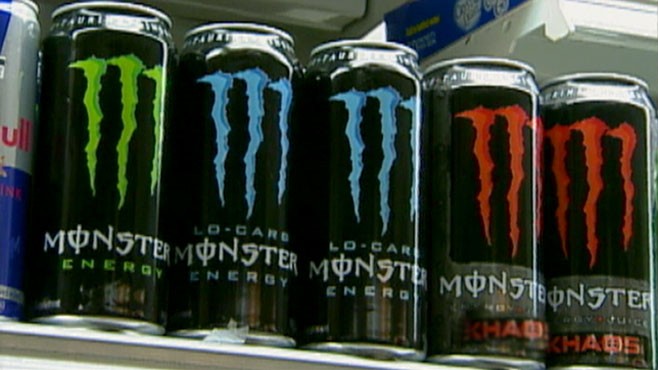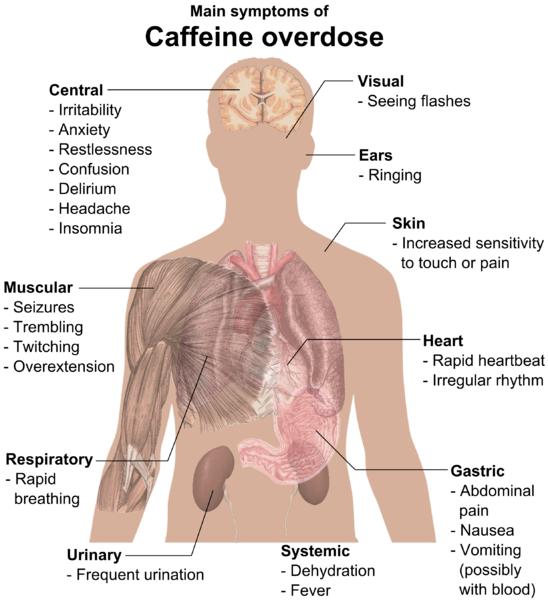
Energy drinks are regularly consumed by 30% to 50% of children, adolescents, and young adults. Research has indicated that they provide no therapeutic benefit and are associated with risks for serious adverse health effects.
Congress is finally demanding greater regulation of the energy products industry which creates drinks like Monster Energy, Monster Rehab, Monster Assault, Monster Heavy Metal, Red Bull, Rock Star, and energy “shots” like 5-hour Energy. These products have been aggressively marketed to teenagers and other young people up until now.
The main ingredients in energy drinks are caffeine, taurine and glucuronolactone. Some new drinks on the market also contain opium poppy seed extract or ephedrine. Caffeine is a stimulant which acts on the central nervous system to speed up the messages to and from the brain, so that the person feels more aware and active.
Since energy drinks are categorized as nutritional supplements, they avoid the limit of 71 mg caffeine per 12 fluid ounces that the US Food and Drug Administration has set for soda, as well as the safety testing and labeling that is required of pharmaceuticals. Consequently, energy drinks can contain as much as 75 to 400 mg caffeine per container, with additional caffeine not included in the listed total often coming from additives such as guarana, kola nut, yerba mate, and cocoa.
The caffeine content of some popular energy drinks and soft drinks [per 250 ml (or 8.45 oz.) beverage]:
- Monster Energy: 84.5 mg (10 milligrams of caffeine per ounce)
- Impulse: 88 mg
- Red Bull: 80 mg
- Naughty Boy: 80mg
- ‘V’: 78 mg
- Coca-Cola: 48.75 mg
- Diet Coke: 48 mg
- Diet Coke Caffeine-Free: 2 mg
- Pepsi: 40 mg
- Diet Pepsi: 44 mg
- Pepsi Max: 44 mg
Monster Energy, a popular energy drink high in caffeine, may have contributed to the deaths of 5 people during the last 3 years, according to the Food and Drug Administration, including that of Anais Fournier, a 14-year-old Maryland girl, who died of “cardiac arrhythmia due to caffeine toxicity” after drinking this product in December on 2 consecutive days. A 24-ounce can of Monster Energy contains 240 milligrams of caffeine.
An energy “shot” sold by Living Essentials of Farmington, Michigan, 5-hour Energy, has been implicated in more than 30 serious or life-threatening events since 2009, including heart attacks, convulsions, and in one case, a spontaneous abortion, according to the Food and Drug Administration (4).
Unlike Monster Energy, Red Bull, and some other energy drinks that resemble beverages, 5-Hour Energy is sold as a “shot” in a 2-ounce bottle. Living Essentials does not disclose the amount of caffeine in each bottle, but a recent article published by Consumer Reports placed that level at about 215 mg (3).
An eight-ounce cup of coffee, depending on how it is made, can contain from 100 to 150 milligrams of caffeine.
The New York Times has reported that another federal agency, the Substance Abuse and Mental Health Services Administration, verified that more than 13,000 emergency room visits in 2009 were associated with energy drinks alone.
Health risks related to energy drinks include:
- Abdominal pain
- Nausea
- Gastrointestinal upset
- Vomiting
- Tremors/shaking
- Headache
- Dizziness
- Chest pain/ischaemia
- Paraesthesia (Tingling or numbing of the skin)
- Insomnia
- Liver damage
- Kidney failure
- Respiratory disorders
- Agitation
- Confusion
- Seizures
- Psychotic conditions
- Rhabdomyolysis
- Tachycardia
- Cardiac arrhythmias/dysrhythmias (Abnormal heart rate)
- Hypertension
- Myocardial infarction
- Heart failure
- Death
Instead of reaching for an energy drink, boost your energy the old-fashioned way:
- Stay well-hydrated by drinking plenty of clean, fresh water each day.
- Go to bed earlier, so you average 8-10 hours of sleep each night.
- Follow a wholesome, nutrient-dense diet, including fruits, vegetables, whole grains, nuts and seeds, legumes, protein from fish, poultry, lean meats, and non-fat or low-fat dairy foods.
- Avoid foods high in sugar, salt, saturated animal fat, partially hydrogenated and tropical oils (trans fats), as well as, foods that have been processed or commercially-prepared.
- Exercise for at least 30 minutes each day, in order to concentrate and feel better, reduce stress, and help raise your metabolic rate.
- Get plenty of fresh air into your lungs by taking a brisk walk outdoors.
References:
- “Caffeine: Main Symptoms of Caffeine Overdose.” Diagram from Wikipedia: The Free Encyclopedia. 10/17/12.
- “Energy Drinks Pose Serious Health Risks for Young People.” Medscape Medical News © 2011 WebMD, LLC. (Source: www.medscape.com/viewarticle/737311).
- Meier, Barry. “Caffeinated Drink Cited in Reports of 13 Deaths.” The New York Times: Business Day. 11/14/12.
- “US Regulators Report Possible Links Between Caffeine Shot,Deaths.” Yahoo!Health. 11/14/12.

Comments on this entry are closed.